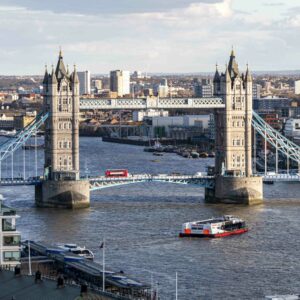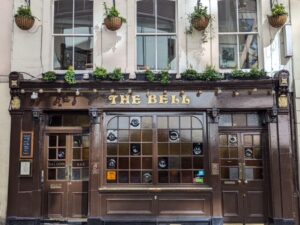At Six in the City we all love a biscuit, but Britain’s love of sugar is rooted in the slave trade as sugar was produced by an enslaved workforce for over 170 years. Sugar was such a valuable commodity that it was known as ‘white gold’ and as well as driving the slave trade, the sugar trade was also the engine for the sugar refining industry in the City of London, known at that time as sugar bakers. London’s streets, rather than being paved in gold, were in fact sticky with sugar.
Sugar Loaves
Sugar originally was sold in cones, known as sugar loaves. It was whitened and wrapped in blue paper to preserve the whiteness of the sugar and then pieces of the sugar were broken off using sugar nips. The whiter the sugar, the better the grade and the smaller, whitest cones were the most expensive.
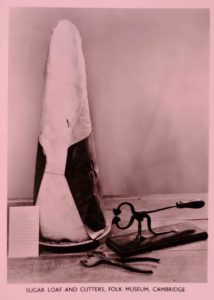
©2021 Ildiko Bita
Sugar was sold by grocers and was so popular that many grocers had sugar loaves on the sign hanging outside their shop. The Sugarloaf pub on Cannon St near St Paul’s Cathedral still exists today, a Sugar Bakers Court can be found near the Gherkin, and a Sugar Quay used to be located between the Custom’s House and the Tower of London.
Sugar’s value is illustrated by the fact it appears in the Old Bailey criminal reports as the target for thieves. Philip Goodson, coachman to Robert Ashurst, a sugar baker, is a case in point and was prosecuted in July 1718 for theft and grand larceny for stealing 26 pounds of sugar, value 9 s. (worth about £100 today) and hiding it under the manger in the stable. Despite the Biblical hiding place, he was found guilty and sentenced to be transported.
German Sugar Bakers
Sugar bakers are mentioned by John Stow in his Survey of London and he records that in 1544 there were only two sugar houses in London as they were unprofitable due to competition from the many sugar bakers in Antwerp.
However, the industry grew significantly with the ascension to the throne of George I in 1714. German bankers, artists and merchants followed the king’s household to England, including German and Dutch sugar bakers who set up sugar houses in partnership with the English. The word ‘sugar baker’ is actually a direct translation of the German word ‘Zukerbäcker’ and many German migrants came to Britain to work, particularly from the area around Hamburg, as German sugar boilers were considered the best.
To begin with, much of the refining took place in the City of London around Upper St Thames Street (near the Sugarloaf pub) and in the area around St Paul’s Cathedral. Later the industry moved to the East End of London due to fire regulations in 1807 which provided that new sugar houses had to move to the suburbs. The process unfortunately was a fire hazard, and the sugar syrups would catch fire, which is why the sugar boilers lived on site to quickly deal with any fires that arose.
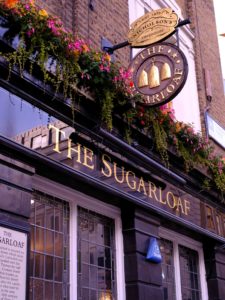
©2021 Ildiko Bita
This migration of workers from Germany continued when the sugar refining industry was in the East End and a German community was established there with a German church, and even German bands going round the sugar houses to play for the workforce at the weekends.
Sugar Baking process
The sugar was grown in the British colonies in the West Indies using enslaved labour, but refined in the UK, as the colonies were prevented from refining the sugar themselves due to high taxes.
The sugar would arrive in its unrefined state, resembling demerara sugar, in hogsheads (very large wooden barrels holding ½ to ¾ of a ton) and be unloaded at the wharves along the river Thames and taken to the nearby sugar houses.
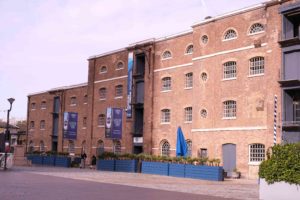
©2022 Ildiko Bita
The sugar houses themselves were a large complex of buildings. Harman Samler, a prominent sugar baker, in 1758 had a sugar house at 26 Water Lane, Blackfriars that backed onto the River Fleet (Water Lane is shown on the Agas map) and the property consisted of a dwelling house, timber yard, sugar mill house and stables.
The process of refining sugar was very laborious and took 2-3 weeks to complete. First the raw sugar was dissolved in lime water and heated in large open-top copper cisterns above open fires. Bullocks’ blood was then added to purify the sugar. The albumen in the blood caused a thick scum to form on the top which captured impurities. This clarifying process was repeated a number of times and the liquid filtered through blankets. It was then boiled to 115⁰C (240⁰F) in pans until the liquid had disappeared. Conditions were so hot that the workers were allowed an unlimited supply of beer!
For the final part of the process, the resultant sugar was formed into cones in earthenware moulds and the cones were turned upside down, with the narrow end pointing downwards to drain. Once dry the sugar cone was neatened into a smooth cone, wrapped in blue paper and sold to the general public as loaves weighing 1 to 3 pounds.
So, the next time you reach for another slice of cake or watch the Great British Bake Off, pause for a moment and consider the history of the white gold we love so much today.
Join Ildiko for Slavery and the City and the Immigrant London walk.
Sources
Sugar Bakers and Sugar Refiners Database
Stobart, Jon., Sugar & Spice – Grocers and Groceries in Provincial England 1650-1830
Williams, Eric., Capitalism & Slavery

